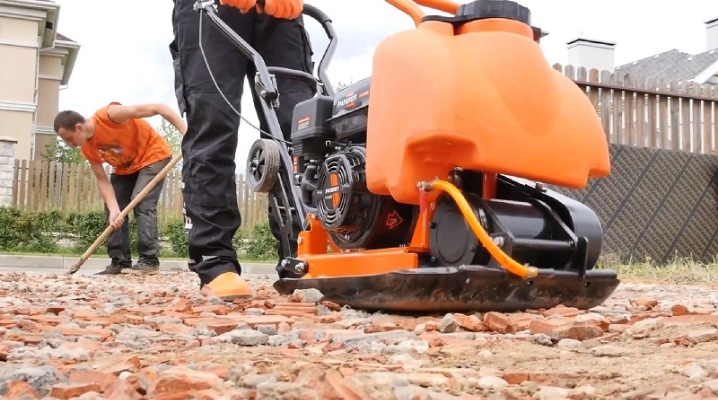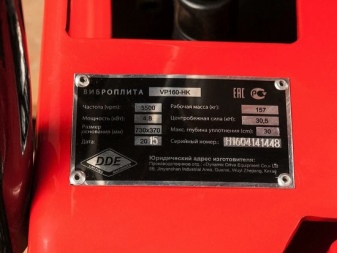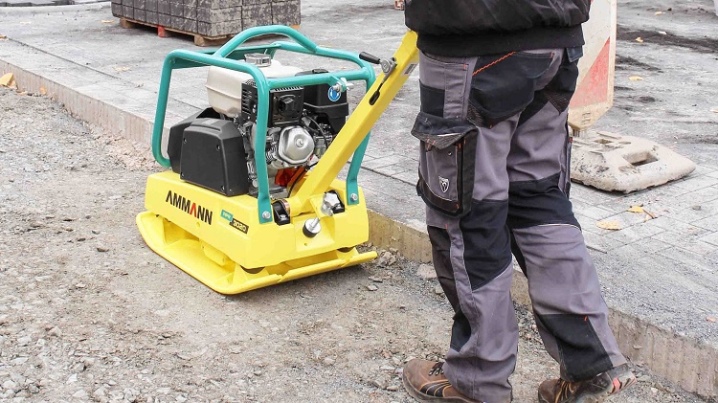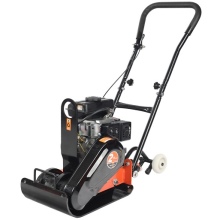All about petrol vibratory plates

Strength and reliability are the main characteristics of any road, as well as foundations, especially any building or premises. In order for the foundation to be the strongest and most dense, gasoline vibrating plates are used, which will be discussed today.


Device and principle of operation
Before getting acquainted with the main characteristics, you should learn more about what the principle of operation of this tool is, and what it consists of. And it consists of 3 main parts.
- Base plate - the lowest part of the vibrating plate, which performs the main work - compacts the surface. For the tamping effect to be of the highest quality, the plate must have the necessary mass and sole area, which increases the speed of work.
- Cylindrical vibrator - the part of the tool that creates vibration, due to which the operation of the entire device is possible. The principle of operation resembles a flywheel, the structure consists of a shaft with a shifted center of gravity. It is this shaft that creates pressure on the plate, which will compact the surface.
- Engine - the basis of all energy in this device. They are different: gasoline, electric and diesel. The main advantages of the gasoline version are ease of operation, mobility, and unpretentiousness. Disadvantages include excessive noise and air pollution.


If you more succinctly describe the way of work and how it works, then the process is the initial generation of energy imbalance by the engine at revolutions, which drives the centrifugal clutch, various shock absorbers and the vibrator itself. That, in turn, moving up and down, exerts the main asymmetric pressure on the plate and thereby activates it.
After that, the pressure goes to the lower part of the unit and already there the main purpose of the tool is performed - tamping the surface.


Main characteristics
Dimensions and weight
These parameters should primarily depend on the purpose of using the technique. When it comes to working with a foundation or road, then more weight and dimensions can play an important role. In terms of numbers, the preferred weight of a large unit starts from 90 kg or more. This is quite enough to put significant pressure on the surface and carefully work out the depth. There are also small units, the main purpose of which is to work with various stone and concrete products, for example, curbs or sidewalk. In these cases, their weight is over 70, but less than 90 kg, depending on the final destination.
When selecting gasoline vibrating plates, it is important to know the optimal weight and pressure, since an excess of these indicators can deform the product. For work inside the house, it is also better to use low-power cookers, which cannot lead to serious consequences. If you decide to buy a heavy model, then make sure that it is equipped with a reversing motion, allowing the car to move not only forward, but also backward.


Vibration shock strength
This indicator is responsible for the direct pressure on the surface and its depth. The more difficult the work, the more vibration force will be needed. As an example, you can cite different depths when laying paving slabs (15 cm) or patching roads (25 cm). The greater the weight and vibration impact of the plate, the more effective the technique will be. As for the digital indicators, the force of the vibration shock is calculated in kilonewtons. For a home, this indicator should not exceed 18-20 units, but if we are talking about more complex and time-consuming projects, then from 20 or more, depending on the characteristics of the work.

Sole area
A very important parameter that determines the performance of work on laying the surface. Since the operation of the engine, the actuation of various elements by it ultimately leads to vibration and pressure on the plate, the ratio of the sole area to the final power is very important. The higher the sole area, the more surface you can influence through the lower part of the device. But here it is worth saying that the vibration force acts smoothly and on the entire area of the sole, so make sure that the final force is enough to complete the work.
Each model is individual in this regard, so it is important to calculate based on the scope of application of such a technique. In any case, not only the effect on the surface, but also the ease of use depends on the sole area. Models with a smaller bottom are more mobile, generally smaller and therefore require less storage space.

Engine
Since we are talking about a gasoline engine, an internal combustion engine is best suited. It has a high efficiency, it is quite easy to use and unpretentious. As a rule, Japanese four-stroke engines are used, which have excellent endurance and consume less fuel compared to other models from different countries. Engine power varies from 4 to 14 hp. with. depending on the specific model.
If the unit has too high power, and the engine does a lot of work, then a cooling system is installed on it to maintain the temperature inside the unit. Thus the risks of engine overheating, its rapid wear or even failure are minimized.

Applications
Given the variety of gasoline vibrating plates, they have a wide range of applications. As noted earlier, there are low-power models designed for household use and low-cost work in the form of laying tiles or borders. More powerful units are used in compaction of deep soil, roads, as well as wide foundations for future buildings and structures.
Vibratory plates can be used to fill deep trenches, but for these purposes, models with a high vibration impact force are used.


Popular models
For a more complete understanding of such a technique, you should make a small kind of rating, where you can present the best models from various brands and manufacturers in their categories.
- CHAMPION PC9045F - a well-known model, which is distinguished by its compactness and power. 6.5 HP engine with. will allow you to perform work of varying complexity, and the impact force of 15 kN - to effectively compact crushed stone, sand, lay asphalt or repair road surfaces. Of the features, it is worth noting the presence of a manual start starter, a sensor for tracking the fuel level, as well as the lightness of the design.

- DDE VP160-HK - a reversing plate with a Japanese Honda engine with a capacity of 6 liters. with. One of the advantages is the elaboration of the depth and the large force of the vibration shock, which is equal to 30.5 kN. For transportation there are special wheels, high quality internal structure.

- RedVerg RD-29155 - straight forward analog, which is suitable for both home and professional use. 6.5 liter four-stroke engine. with. with an impact force of 13 kN makes this model very comfortable and efficient. The design provides for the presence of a soft anti-vibration handle, there is an irrigation system, a protective casing is built-in.

- Elitech HTP 60BVL - a simple vibrating plate for semi-professional use. Engine power of 6.5 liters. with.and a vibration shock of 10.5 kN is enough to solve most surface laying tasks. Simple operation, wide temperature range, shockproof casing and anti-vibration system are the main advantages of this unit.

It is also worth noting domestic manufacturers under the Zubr, Vektor and Patriot brands, which offer vibratory plates of various capacities and applications at a more affordable price.
The models presented in the rating have semi- and professional levels, Russian models are simpler and more applicable in everyday life.



Criterias of choice
As with the selection of any technique, first of all pay attention to the characteristics. Having previously studied some of them, you will be able to form your own idea of what parameters should have a suitable technique for you. Do not forget about the design, which can include a protective casing, an irrigation system, transport wheels and much more, which will facilitate the use of a vibrating plate. Of course, do not neglect reading reviews from real owners.


Operating tips
Before starting work with such tools, it is necessary to familiarize yourself with how to properly operate the unit. Vibratory plates themselves are unpretentious and do not require special conditions of detention, but, like any equipment, they have basic safety requirements.
- The surface of the vibrating plate must be cleaned; small particles and other elements that can disrupt the operation of the equipment must not get inside the device.
- As for the fuel equipment, the level of gasoline and oil must be checked periodically so that it does not happen that at an inconvenient moment your unit stops working. For such engines, it is worth pouring in unleaded AI-92 gasoline. It is worth saying that such a fuel is suitable for most equipment with Japanese engines, so the option is quite versatile.
- The recommended oil for use is 5W30. After checking the fuel level, make sure that all components of the equipment are clean and there are no spilled gasoline or oil on them, and if they remain, remove them.
- It is not recommended to store vibrating plates near heat sources or any other heating elements, as well as to keep equipment in humid places. Do not allow water and other liquids to enter the unit.
- If you are faced with a breakdown of the vibrating plate, then the best solution would be to contact a technical service for the repair of such equipment.
Also, do not forget about the instructions that come with the model. After reading this document, you will receive a complete description of the technical characteristics and features of the operation of the unit.


In the next video, you will find an overview of the Wacker MP 15 petrol vibratory plate.











The comment was sent successfully.